|
The Art and Nature of Fresco Main Page Introduction The Feminine & Fresco Creation Choosing a Wall Designing Murals Lime & Sand Plastering Color Painting Gallery Artist Biography Who Owns a Work of Art? Women Muralists Fresco Links Contact Us A Life in Art and Spirituality |
The Art of Fresco: Choosing a Wallby Sr. Lucia Wiley, CHS
Just as the longevity of an oil painting depends in part on the way one prepares the canvas, the wall on which the fresco will live effects the life of the fresco. Many frescoes have been lost or damaged because of the wall that holds them. On the other hand, a "healthy" wall will support a fresco for thousands of years. While Leonardo da Vinci's "Last Supper" is not a fresco, I like to use it as an example. It was the construction of the wall itself which has been largely responsible for the deterioration of the painting. The foundation wall upon which it is painted is rock, resting directly upon the ground. Moisture from the earth has crept up the wall, loosening the plaster and loosening the paint. Many frescoes have also been lost for this same reason. Present day building methods and materials have made damp walls unnecessary. Below I have listed several types of walls which create suitable homes for frescoes.
These are elements to keep in mind when choosing a wall:
© the estate of Lucia Wiley; used by permission image: "Indians Gathering Wild Rice," 1939 in the Long Prairie, Minnesota Post Office; true fresco, 7'x15' |